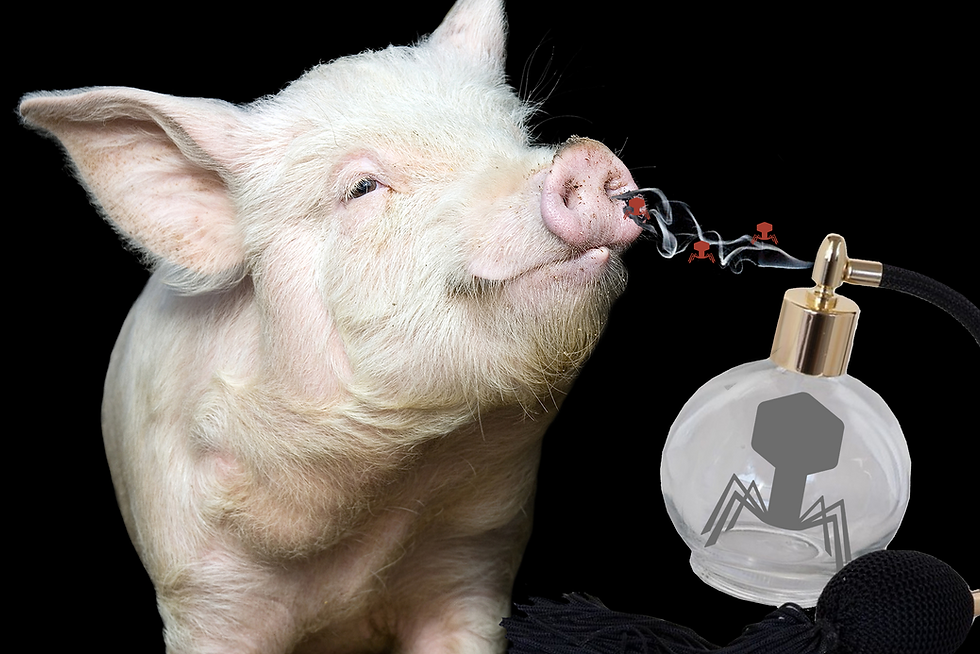Reducing airborne viruses: 4 disinfectants tested
- Caroline Duchaine (Laval University)
- 3 avr. 2017
- 3 min de lecture
Winter weather promotes the spread of viruses between farms. Therefore, to minimize the risk of contaminating farms that are free of viruses such as PRRSV or influenza, farms have put in place biosafety measures in addition to processes, including air filtration. In spite of these precautionary measures, new cases emerge yearly and some infections, such as avian flu that is currently making headlines in Europe, cause major economic losses as well as an infectious disease crisis.

Dr. Caroline Duchaine is a bioaerosols expert at the CRIPA* interested in identifying and testing new methods that reduce the concentration of virions in the air. She is specifically interested in reducing the number of virions found in bioaerosols. In order to safely test the ability of compounds to destroy airborne viruses that infect humans, animals or plants, such as influenza, new laboratories with very high-levels of bio-containment would have to be built. As this, unfortunately, is not possible experiments are performed using surrogate viruses that only infect bacteria called bacteriophages. These viruses (bacteriophages) are not dangerous to humans, animals and plants because they only and specifically infect certain bacterial species. In addition to being safer to handle, bacteriophages are structurally similar to the viruses that cause influenza and Newcastle disease, together representing the most important infections in the poultry industry. With this knowledge, in collaboration with her colleague Dr. Sylvain Moineau, an expert in bacteriophages at the Centre Félix d’Hérelle based at the Université de Laval, Dr. Duchaine set out to test the efficacy of 4 disinfectants against aerosolized viruses. The study of infectious viral particles present in aerosols is a relatively new field. As a result, the methods to detect and analyse airborne viral particles indoors are constantly evolving. This is why Dr. Enric Robinedy, a specialist in the analysis of indoor bioaerosols from the Centre Scientifique et Technique du Bâtiment in France, was asked to share his knowledge and supervise this aspect of the study.
Of the four commercial product tested, Pledge and Eugenol were more effective against the airborne viruses than MiST or hydrogen peroxide. Notably, when humidity levels are low (25%), both Pledge and Eugenol reduced the infectious potential of the bacteriophages used as surrogates for the viruses causing influenza and Newcastle disease. However, only Pledge was still effective when tested at a higher humidity level (50%). Additionally, Pledge was the only commercial product whose use would respect the norms for human respiratory exposure in a closed space, as determined by the American Conference of Governmental Industrial Hygienists (ACGIH). Specifically, the effective concentration/dose is below the maximum exposure limit for an 8-hour workday.
In agricultural settings, it is important for farmers to understand that there are no identified conditions that will simultaneously reduce the amount of all types of viruses in the air. This is because survival conditions are specific for a given virus and can vary greatly between different kinds of viruses. For example, influenza virus thrives at 20% or 70% humidity but struggles between 40% and 50%. Conversely, coronaviruses, including PEDV found in swine production, survive best at 50% humidity. Other factors such as ambient temperature can also influence viral survival. Therefore, it isn’t possible to guarantee air safety by strictly regulating environmental conditions and, at best, knowing environmental conditions can be used to monitor risk.
Existing and prospective air filtration technologies, such as UV or ozone treatment, offer interesting solutions. Researchers will have to evaluate processes that combine more than one method (e.g. disinfectant with UV) and test them under conditions present on farms. For example, the levels of Pledge used in this study would be acceptable for humans during an 8-hour workday; however, it must be tested if these exposure levels become unacceptable if animals exposed to the same Pledge concentrations remain in the farm building. Furthermore, cost-benefit analyses are required to decide if these solutions should be used during normal farm operations or exclusively during epidemics.
*Swine and Poultry Infectious Diseases Research Center
Nathalie Turgeon, Kevin Michel, Thi-Lan Ha, Enric Robine, Sylvain Moineau, Caroline Duchaine.
PLoS ONE 11(12): e0168815.







































Commentaires